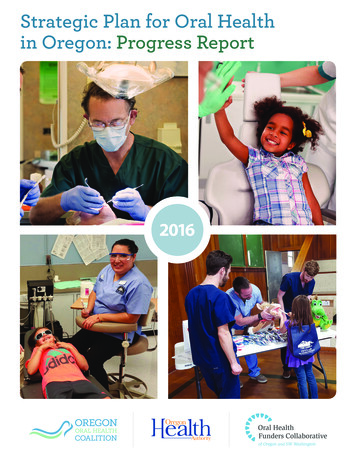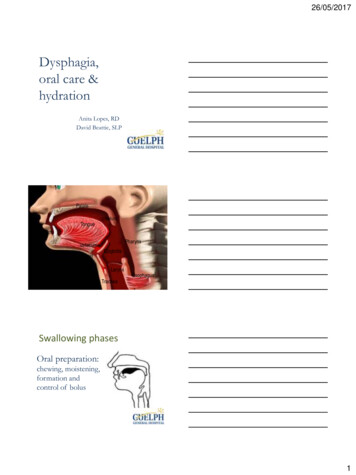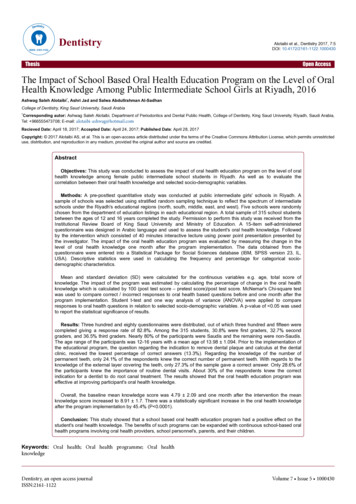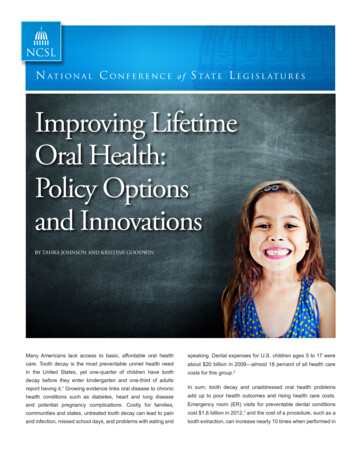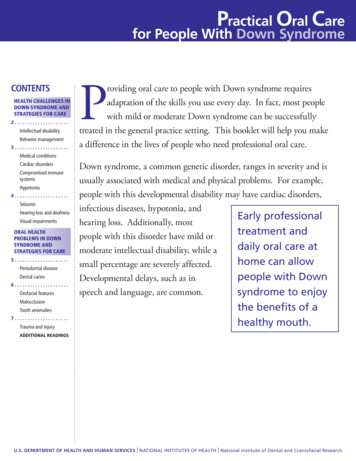
Transcription
Practical Oral Carefor People With Down SyndromecontentsHealth Challenges INdown syndrome andStrategies for Care2.Intellectual disabilityBehavior management3.Providing oral care to people with Down syndrome requiresadaptation of the skills you use every day. In fact, most peoplewith mild or moderate Down syndrome can be successfullytreated in the general practice setting. This booklet will help you makea difference in the lives of people who need professional oral care.Medical conditionsCardiac disordersCompromised immunesystemsHypotonia4.SeizuresHearing loss and deafnessVisual impairmentsOral healthproblems IN downsyndrome andstrategies for care5.Periodontal diseaseDental caries6.Orofacial featuresDown syndrome, a common genetic disorder, ranges in severity and isusually associated with medical and physical problems. For example,people with this developmental disability may have cardiac disorders,infectious diseases, hypotonia, andEhearing loss. Additionally, mostpeople with this disorder have mild ormoderate intellectual disability, while asmall percentage are severely affected.Developmental delays, such as inspeech and language, are common.MalocclusionTooth anomalies7.Trauma and injuryAdditional ReadingsU.S. DEPARTMENT OF HEALTH AND HUMAN SERVICES l National Institutes of Health l National Institute of Dental and Craniofacial Research
Health Challenges in downsyndrome and strategies for CarePeople with Down syndrome may presentwith mental and physical challenges thathave implications for oral care. Beforethe appointment, obtain and review thepatient’s medical history. Consultationwith physicians, family, and caregivers isessential to assembling an accurate medicalhistory. Also, determine who can legallyprovide informed consent for treatment.Address yourpatient directlyand with respect.Intellectual disability. Althoughthe mental capability of people with Downsyndrome varies widely, many have mild ormoderate intellectual disability that limitstheir ability to learn, communicate, andadapt to their environment. Languagedevelopment is often delayed or impairedin people with Down syndrome; theyunderstand more than they can verbalize.Also, ordinary activities of daily living andunderstanding the behavior of others aswell as their own can present challenges.Listen actively, since speaking maybe difficult for people with Downsyndrome. Show your patient whetheryou understand.Talk with the parent or caregiver todetermine your patient’s intellectualand functional abilities, then explaineach procedure at a level the patientcan understand. Allow extra time toexplain oral health issues or instructionsand demonstrate the instrumentsyou will use.Use simple, concrete instructions, andrepeat them often to compensate forany short-term memory problems.Behavior management is not usually a problem in people with Downsyndrome because they tend to be warmand well behaved. Some can be stubbornor uncooperative, but most just needa little extra time and attention to feelc omfortable. Gaining the patient’s trustis the key to successful treatment.Talk to the caregiver or physicianabout techniques they have found tobe effective in managing the patient’sbehavior. Share your ideas with them,and find out what motivates the patient.It may be that a new toothbrush at theend of each appointment is all it takesto ensure cooperation.Schedule patients with Down syndromeearly in the day if possible. Earlyappointments can help ensure thateveryone is alert and attentive and thatwaiting time is reduced.Set the stage for a successful visit byinvolving the entire dental team—fromthe receptionist’s friendly greeting to thecaring attitude of the dental assistant inthe operatory.Provide oral care in an environmentwith few distractions. Try to reduceunnecessary sights, sounds, or otherstimuli that might make it difficult foryour patient to cooperate. Many peoplewith Down syndrome, however, enjoymusic and may be comforted by hearingit in the dental office during treatment.Plan a step-by-step evaluation, startingwith seating the patient in the dentalchair. If this is successful, performan oral examination using only yourfingers. If this, too, goes well, beginusing dental instruments. Prophylaxisis the next step, followed by dentalradio graphs. Several visits may beneeded to accomplish these tasks.Try to be consistent in all aspects of providing oral health care. Use the samestaff, dental operatory, appointmenttimes, and other details to help sustainfamiliarity. The more consistency youprovide for your patients, the more likelythat they will be cooperative.2
down syndromeComfort people who resist oral careand reward cooperative behavior withcompliments throughout the appointment.Use immobilization techniques onlywhen absolutely necessary to protectthe patient and staff during dentaltreatment—not as a convenience.There are no universal guidelineson immobilization that apply to alltreatment settings. Before employingany kind of immobilization, it mayhelp to consult available guidelineson federally funded care, your Statedepartment of mental health/disabilities,and your State Dental Practice Act.Guidelines on behavior managementpublished by the American Academyof Pediatric Dentistry (http://www.aapd.org)may also be useful. Obtain consentfrom your patient’s legal guardian andchoose the least restrictive techniquethat will allow you to provide caresafely. Immobilization should not cause physical injury or undue discomfort.Medical conditions. Though theiraverage life expectancy has risen to themid-50s, people with Down syndrome arestill at risk for problems in nearly everysystem in the body. Some problems aremanifested in the mouth. For example, oralfindings such as persistent gingival lesions,prolonged wound healing, or spontaneousgingival hemorrhaging may suggest anunderlying medical condition and warrantconsultation with the patient’s physician.Cardiac disorders are commonin Down syndrome. In fact, mitral valveprolapse occurs in more than half of alladults with this developmental disability.Many others are at risk of developingvalve dysfunction that leads to congestiveheart failure, even if they have no knowncardiac disease. Consult the patient’sphysician if you have questions about themedical history and the need for antibioticprophylaxis (http://www.heart.org).Compromised immune systemslead to more frequent oral and systemicinfections and a high incidence ofperio dontal disease in people with Downsyndrome. Aphthous ulcers, oral Candidainfections, and acute necrotizing ulcerativegingivitis are common. Chronic respiratoryinfections contribute to mouth breathing,xerostomia, and fissured lips and tongue.Treat acute necrotizingulcerative gingivitis and otherinfections aggressively.Talk to patients and their caregiversabout preventing oral infections withregular dental appointments and dailyoral care.Stress the importance of usingfluoride to prevent dental cariesassociated with xerostomia.Use lip balm during treatment to easethe strain on your patient’s lips.More than halfof all adults withDown syndromeexperience mitralvalve prolapse.Hypotonia affects the muscles in various areas of the body, including themouth and large skeletal muscles. When itinvolves the mouth, it leads to an imbalanceof forces on the teeth and contributes to anopen bite. If the muscles controlling facialexpression and mastication are affected,problems with chewing, swallowing,drooling, and speaking can result. Arelated problem is atlantoaxial instability, aspinal defect that increases the mobility ofthe cervical vertebrae and often leads to anunsteady gait and neck pain.Maintain a clear path for movementthroughout the treatment setting.Determine the best position for yourpatient in the dental chair and the safestway to move his or her body, especiallythe head and neck. Talk with thephysician or caregiver about ways toprotect the spinal cord. Use pillows tostabilize your patient and make him orher more comfortable.3
Seizures sometimes occur in thispopu lation, especially among infants,but can usually be controlled withanticonvulsant medications. The mouthis always at risk during a seizure: Patientsmay chip teeth or bite the tongue or cheeks.People with controlled seizure disorders caneasily be treated in the general dental office.Consult your patient’s physician.Record information in the chartabout the frequency of seizures andthe medications used to control them.Determine before the appointmentwhether medications have been takenas directed. Know and avoid any factorsthat trigger your patient’s seizures.Be prepared to manage a seizure. Ifone occurs during oral care, removeany instruments from the mouthand clear the area around the dentalchair. Attaching dental floss to rubberdam clamps and mouth props whentreatment begins can help you removethem quickly. Do not attempt to insertany objects between the teeth duringa seizure.Stay with your patient, turn him or herto one side, and monitor the airway toreduce the risk of aspiration.Hearing loss and deafness mayfurther complicate poor communicationskills, but these, too, can be accommodatedwith planning. Patients with a hearingproblem may appear to be stubbornbecause of their seeming lack of responseto a request.Patients may want to adjust their hearing aids or turn them off, since thesound of some instruments may causeauditory discomfort.If your patient reads lips, speak in anormal cadence and tone. If yourpatient uses a form of sign language,ask the interpreter to come to theappointment. Speak with this personin advance to discuss dental terms andyour patient’s needs.Visual feedback is helpful. Maintaineye contact with your patient. Beforetalking, eliminate background noise(turn off the radio and the suction).Sometimes people with a hearing losssimply need you to speak clearly ina slightly louder voice than normal.Remember to remove your facemaskfirst or wear a clear face shield.Visual impairments such asstrabismus (crossed or misaligned eyes),glaucoma, and cataracts can affect peoplewith Down syndrome.Determine the level of assistance yourpatient requires to move safely throughthe dental office.Use your patients’ other senses toconnect with them, establish trust, andmake treatment a better experience.Tactile feedback, such as a warm handshake, can make your patientsfeel comfortable.Face your patients when you speak andkeep them apprised of each upcomingstep, especially when water will be used.Rely on clear, descriptive language toexplain procedures and demonstratehow equipment might feel and sound.Provide written instructions in largeprint (16 point or larger).Record in the patient’s chartstrategies that were successful inproviding care. Note your patient’spreferences and other uniquedetails that will facilitate treatment,such as music, comfort items, andflavor choices.4
down syndromeOral Health Problems in DownSyndrome and Strategies for CarePeople with Down syndrome have nounique oral health problems. However,some of the problems they have tend tobe frequent and severe. Early professionaltreatment and daily care at home can mitigate their severity and allow peoplewith Down syndrome to enjoy the benefitsof a healthy mouth.Periodontal disease is themost significant oral health problem inpeople with Down syndrome. Childrenexperience rapid, destructive periodontaldisease. Consequently, large numbers ofthem lose their permanent anterior teethin their early teens. Contributing factorsinclude poor oral hygiene, malocclusion,bruxism, conical-shaped tooth roots,and abnormal host response because ofa compromised immune system.Some patients benefit from the dailyuse of an antimicrobial agent suchas chlorhexidine. Recommend anappropriate delivery method based onyour patient’s abilities. Rinsing, forexample, may not work for a personwho has swallowing difficulties or onewho cannot expectorate. Chlorhexidineapplied using a spray bottle ortoothbrush is equally efficacious.If use of particular medications has ledto gingival hyperplasia, emphasize theimportance of daily oral hygiene andfrequent professional cleanings.Encourage independence in daily oralhygiene. Ask patients to show you howthey brush, and follow up with specificrecommendations on brushing methodsor toothbrush adaptations. Involvepatients in hands-on demonstrationsof brushing and flossing.Some people with Down syndromecan brush and floss independently, butmany need help. Talk to theircaregivers about daily oral hygiene.Do not assume that all caregivers knowthe basics; demonstrate proper brushingand flossing techniques. A powertoothbrush or a floss holder can simplifyoral care. Also, use your experienceswith each patient to demonstrate sittingor standing positions for the caregiver.Emphasize that a consistent approachto oral hygiene is important—caregiversshould try to use the same location, timing, and positioning.Dental caries. Children and youngadults who have Down syndrome havefewer caries than people without thisdevelopmental disability. Several associatedoral conditions may contribute to this fact:delayed eruption of primary and permanentteeth; missing permanent teeth; and smallsized teeth with wider spaces betweenthem, which make it easier to removeplaque. Additionally, the diets of manychildren with Down syndrome are closelysupervised to prevent obesity; this helpsreduce consumption of cariogenic foodsand beverages.By contrast, some adults with Downsyndrome are at an increased risk of cariesdue to xerostomia and cariogenic foodchoices. Also, hypotonia contributes tochewing problems and inefficient naturalcleansing action, which allow food toremain on the teeth after eating.Tips for caregivers are available in the bookletDental Care Every Day: A Caregiver’s Guide, also part of this series.5
Advise patients taking medicines thatcause xerostomia to drink water often.Suggest taking sugar-free medicinesif available and rinsing with waterafter dosing.unusual thickness of the sides of thehard palate. This thickness restricts theamount of space the tongue can occupyin the mouth and affects the ability tospeak and chew.Recommend preventive measures suchas topical fluoride and sealants. Suggestfluoride toothpaste, gel, or rinse,depending on your patient’s needsand abilities.The lips may grow large and thick.Fissured lips may result from chronicmouth breathing. Additionally,hypo tonia may cause the mouth todroop and the lower lip to protrude.Increased drooling, compounded bya chronically open mouth, contributesto angular cheilitis.Emphasize noncariogenic foods and beverages as snacks. Advise caregiversto avoid using sweets as incentivesor rewards.Several orofacial features arecharacteristic of people with Downsyndrome. The midfacial region may beunderdeveloped, affecting the appearanceof the lips, tongue, and palate.The maxilla, the bridge of the nose,and the bones of the midface region aresmaller than in the generalpopulation, creating aprognathic occlusalrelationship. Mouthbreathing may occurbecause of smallernasal passages, andthe tongue mayprotrude becauseof a smaller midface region.People withDown syndromeoften have a stronggag reflex due toplacement of thetongue, as well asanxiety associated withany oral stimulation.The palate, although normal sized,may appear highly vaulted and narrow.This deceiving appearance is due to theThe tongue also develops cracks and f issures with age; this condition can contribute to halitosis.Malocclusion is found in mostpeople with Down syndrome because ofthe delayed eruption of permanent teethand the underdevelopment of the maxilla.A smaller maxilla contributes to an openbite, leading to poor positioning of teethand increasing the likelihood of periodontal disease and dental caries.Orthodontia should be carefullyc onsidered in people with Down syndrome. Some may benefit, whileothers may not.In and of itself, Down syndrome is not abarrier to orthodontic care. The abilityof the patient or caregiver to maintaingood daily oral hygiene is critical to thefeasibility and success of treatment.TOOth anomalies are common inDown syndrome.Congenitally missing teeth occurmore often in people with Downsyndrome than in the generalpopulation. Third molars, laterals,and mandibular second bicuspidsare the most common missing teeth.6
down syndromeDelayed eruption of teeth, often followingan abnormal sequence, affects somechildren with Down syndrome. Primaryteeth may not appear until age 2, withcomplete dentition delayed until age 4 or 5.Primary teeth are then retained insome children until they are 14 or 15.Irregularities in tooth formation, suchas microdontia and malformed teeth, arealso seen in people with Down syndrome.Crowns tend to be smaller, and roots areoften small and conical, which can lead totooth loss from periodontal disease. Severeillness or prolonged fevers can lead tohypoplasia and hypocalcification. Examine a child by his or her firstb irthday and regularly thereafter tohelp identify unusual tooth formationand patterns of eruption. Consider using a panoramic radio graph to determine whether teeth arecongenitally missing. Patients oftenfind this technique less threateningthan individual films. Maintain primary teeth as long aspossible. Consider placing spacemaintainers where teeth are missing.TRAUMA and INJURY to the mouthfrom falls or accidents occur in people withDown syndrome. Suggest a tooth-saving kitfor group homes. Emphasize to caregiversthat traumas require immediate professional attention and explain the procedures to followif a permanent tooth is knocked out. Also,instruct caregivers to locate any missingpieces of a fractured tooth, and explain thatradiographs of the patient’s chest may benecessary to determine whether any fragmentshave been aspirated.Physical abuse often presents as oral trauma.Abuse is reported more frequently in peoplewith developmental disabilities than in thegeneral population. If you suspect that achild is being abused or neglected, State lawsrequire that you call your Child ProtectiveServices agency. Assistance is also availablefrom the Childhelp National Child AbuseHotline at (800) 422–4453 or the ChildWelfare Information Gateway(www.childwelfare.gov).Making a difference in the oral healthof a person with Down syndrome maygo slowly at first, but determination canbring positive results—and invaluablerewards. By adopting the strategies discussed in this booklet, you can havea significant impact not only on yourpatients’ oral health, but on theirquality of life as well.AFenton SJ, Perlman S, Turner H (eds.). OralHealth for People with Special Needs: Guidelinesfor Comprehensive Care. River Edge, NJ:Exceptional Parent, Psy-Ed Corp., 2003.Roizen NJ. Down Syndrome. In Batshaw ML,Pellegrino L, Roizen NJ (eds.). Children WithDisabilities (6th ed.). Baltimore, MD: Paul H.Brookes Publishing Co., 2007.Weddell JA, Sanders BJ, Jones JE. Dentalproblems of children with disabilities. InMcDonald RE, Avery DR, Dean JA. Dentistryfor the Child and Adolescent (8th ed.). St.Louis, MO: Mosby, 2004. pp. 524–556.For more information about Down syndrome, contactNational Institute of Child Health and HumanDevelopment Information Resource CenterP.O. Box 3006Rockville, MD 20847(800) h.gov7
National Institute of Dentaland Craniofacial ResearchThis booklet is one in a series on providing oral care for peoplewith mild or moderate developmental disabilities. The issues andcare strategies listed are intended to provide general guidance onhow to manage various oral health challenges common in peoplewith Down syndrome.Other booklets in this series:Continuing Education: Practical Oral Care for PeopleWith Developmental DisabilitiesPractical Oral Care for People With AutismPractical Oral Care for People With Cerebral PalsyPractical Oral Care for People With Intellectual DisabilityWheelchair Transfer: A Health Care Provider’s GuideCenters for Disease Controland PreventionSAFER HEALTHIER PEOPLEDental Care Every Day: A Caregiver’s GuideTMSpecial Care DentistryAssociationFor additional copies of this booklet, contactNational Institute of Dental and Craniofacial ResearchNational Oral Health Information Clearinghouse1 NOHIC WayBethesda, MD ih.govThis publication is not copyrighted.Make as many photocopies as you need.NIH Publication No. 09–5193Reprinted July 2009ACkNOWLEDgMENTSThe National Institute of Dental and Craniofacial Researchthanks the oral health professionals and caregivers who contributed their time and expertise to reviewing andpretesting the Practical Oral Care series.Expert Review Panel Mae Chin, RDH, University of Washington, Seattle, WA Sanford J. Fenton, DDS, University of Texas, Houston, TX Ray Lyons, DDS, New Mexico Department of Health,Albuquerque, NM Christine Miller, RDH, University of the Pacific,San Francisco, CA Steven P. Perlman, DDS, Special Olympics Special Smiles,Lynn, MA David Tesini, DMD, Natick, MA
with mild or moderate Down syndrome can be successfully treated in the general practice setting. This booklet will help you make a difference in the lives of people who need professional oral care. Down syndrome, a common genetic disorder, ranges in severity and is usually associated with medical and physical problems. For example,








